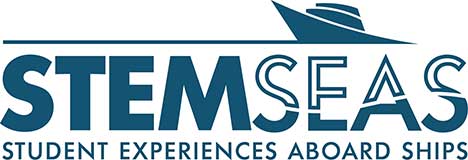



![]()
![]() STEMSEAS Blog (3/18/2025) – AR86-07 – Eric Lewallen
STEMSEAS Blog (3/18/2025) – AR86-07 – Eric Lewallen
Today, aboard the R/V Neil Armstrong, the STEMSEAS participants engaged in a series of educational activities designed to increase awareness and understanding of how oceanographic data are collected, analyzed and interpreted. To begin, we attended a seminar about the types of data that can be collected from moorings that are anchored to the seafloor. Acoustic data are continuously collected to estimate the abundance and distribution of migratory organisms that migrate throughout the water column depending on daily and/or seasonal cycles. Next, we learned about the Argo instruments that are unmanned vehicles that are deployed from ships and remain in the ocean for roughly five years to continuously collect temperature and salinity data at depths of up to 2,000 m. In addition to argo devices, oceanographers commonly use CTD casts from the deck of a ship to obtain detailed temperature and salinity information in a specific area. As a component of our training, we had an opportunity to learn about the long-term data sets that have been generated through a coordinated and international effort to sample the world ocean at a resolution of 3 degrees by 3 degrees. Following a description of how the CTD instruments work, we went onto the deck to observe the devices and ask questions about where each sensor is located and how the samples are stored/collected (attached photo). As a last step in our oceanography training for today, we attended a workshop on how to use Ocean Data View to download and analyze oceanographic data (primarily obtained through CTD casts). In particular, it was fascinating to observe deep ocean currents that originate in the North Atlantic and interact with deep water currents that originate in Antarctica. Depending on latitude, it is possible to observe the consequences of circulating water masses that occur over time scales of nearly 1500 years. Gaining a functional knowledge of how oceanographic data are collected, curated, visualized, and interpreted will prove useful for mentoring students on future STEMSEAS cruises.
Throughout the day, we also sampled seawater from the ship’s circulating seawater system. This system uses an impeller to draw seawater into a tube that pumps water directly into the wet lab. Using a regular spigot, we attached a filtration device to allow 15 minutes of continuous flow (~100 liters) to pass through mesh (10um) that is fine enough to capture phytoplankton (photo attached). In total, we collected 3 types of phytoplankton (2 different radiolarians and 1 foraminifera) demonstrating the potential utility of this flow-through system for student-centered projects that focus on taxonomy, morphology, genetics or biogeography, among others. As team building exercises, we decorated styrofoam cups and exchanged tiny gifts that represent our home institutions or states (e.g., pencils, stickers, lab emblems). The plan is to sink styrofoam cups in a laundry bag attached to an upcoming CTD cast, to observe how they shrink under the pressure of deep ocean conditions. Lastly, to gain additional familiarity with the ship and crew, we visited the bridge to discuss some of the opportunities and challenges associated with maritime professions. The bridge offers spectacular viewing areas for spotting wildlife (photo attached, note the size of the helm). Surprisingly few seabirds have been observable thus far, despite the regular appearance of Atlantic flyingfishes evading the ship (at least while we’re positioned within the Gulf Stream).
We’re looking forward to another exciting day tomorrow!
– Eric Lewallen


